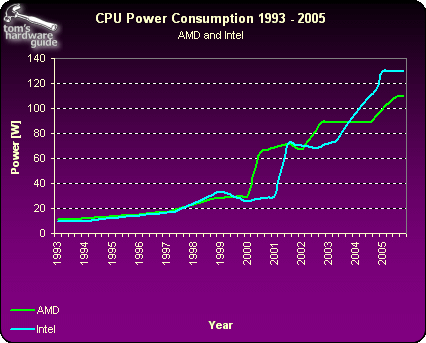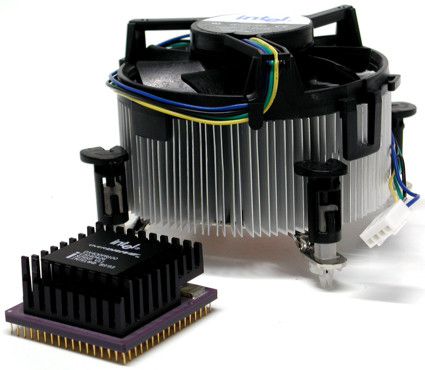The Mother of All CPU Charts 2005/2006
Thermal Dissipation Prevents Higher Clock Speeds
Hand in hand with increasing performance have come increasing power requirements between 1993 and today. With a maximum thermal design power of 130 W now, Intel is more power hungry than its competitor AMD. Up until 1999, both companies followed the same technological path, but after that, their paths diverged. Today, AMD clearly leads Intel both where performance and energy efficiency is concerned.
The astute observer will notice that the clock speed race between the rivaling companies has practically come to a standstill. AMD and Intel now try to work around this fact by using more and more cryptic product naming systems that hide a processor's actual clock speed.
In an overclocking test performed two years ago, our lab in Munich already succeeded in pushing a Pentium 4 to 4 GHz with conventional air-cooling methods. In a world-record attempt (our 5 GHz project), we even achieved 5.25 GHz and the world record is somewhere around 7 GHz today. Yet regular users are still not seeing these speeds.
The biggest problem that the chipmakers face now is that heat dissipation increases with rising frequencies. So far, neither company has been able to find a satisfactory solution. Instead, they have taken advantage of the advances in miniaturization of the processors themselves, and begun incorporating two physical cores onto one die. This technique helps spread the heat more evenly across the processors' surface, while mainly ensuring higher performance than their single-core counterparts even at lower clock speeds when using modern applications.
For now, however, the 4 GHz barrier seems to remain an insurmountable obstacle - at least while trying to retain justifiable heat dissipation levels. After all, a thermal dissipation loss of 130 W requires an expensive and extravagant cooling system that isn't easily realized in the mass market. As a result, the Pentium 4 670 remains the processor with the highest frequency on the Intel side. The problem is not as pronounced (yet?) with AMD CPUs, since their clock speeds - and consequently thermal dissipation loss - are quite a bit lower.
Again, we'd like to present a prime example illustrating this development over the past 12 years. While the original Pentium 60 that was around in 1993 only sported a tiny cooler, today's models require active solutions at the size of an infant's head, and often sound more like vacuum cleaners than computer components. If this trend continues, will we eventually see coolers the size of car radiators?
A picture worth more than a thousand words. In the front is a Pentium Overdrive from 1993, complete with its cooler. The looming presence behind it is "only" the standard Pentium 4 cooler from 2005. Will the future bring us even larger cooling devices?
Get Tom's Hardware's best news and in-depth reviews, straight to your inbox.
Current page: Thermal Dissipation Prevents Higher Clock Speeds
Prev Page Charts Updated With Dual Cores Next Page Facts & Figures - The Evolution Of PerformanceTom's Hardware is the leading destination for hardcore computer enthusiasts. We cover everything from processors to 3D printers, single-board computers, SSDs and high-end gaming rigs, empowering readers to make the most of the tech they love, keep up on the latest developments and buy the right gear. Our staff has more than 100 years of combined experience covering news, solving tech problems and reviewing components and systems.


